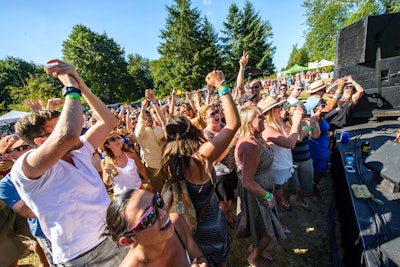
Every summer, outdoor festivals like Coachella draw hundreds of thousands of attendees with extensive music lineups and convivial, entertaining atmospheres. But some attendees such as plus-size people don’t always get to enjoy that same carefree experience.
Many festivals are not designed with body inclusivity in mind, making them inaccessible and uncomfortable for some attendees. But since the majority of the U.S. population is plus size (according to a National Health and Nutrition Examination Survey, more than two in three adults are considered to be overweight or have obesity), event production companies need to consider their entire audience—and the potential for attendee growth—by becoming more size inclusive with additional amenities, assistance, and more.
Here, festival organizers and producers share their advice for making outdoor events more welcoming to those with diverse body types.
Make marketing materials more inclusive.
Promotional materials, from brochures to social media, should reflect the fact that there are plus-size people on the fest grounds, not just straight-size folks. Rebecca Sparks, producer of the High Sierra Music Festival, an annual multi-day fest that takes place in early July in Quincy, California, said that not only will this show how inclusive the festival is, but it will also help to normalize diversity at festivals.
Consider the venue layout.
Hosting a festival at an accessible space is key. Outdoor venues with hard terrain and hills are more difficult for plus-size attendees to navigate, and they may not be able to tough it out for an entire weekend-long event. If the venue is built on difficult turf, consider reconfiguring the festival’s setup. Long walks from the parking lot to the festival area can be arduous, so place main sites close together. “There’s no 45-minute walk from your campsite to the stage. There are no long lines you have to stand in just to buy a bottle of water,” Sparks said about the High Sierra layout, which includes several nearby campsites for attendees.
Gregg Morris, director of marketing for the 4 Peaks Music Festival, agrees with Sparks, adding that at 4 Peaks, organizers arrange for staff to have carts available to drive attendees around the grounds if assistance is needed. (The fest takes place later this month in Bend, Oregon.)
Some festivals also try to create as much shade as possible since the majority of an outdoor venue is usually exposed to direct sun. Sparks explained that at High Sierra, air-conditioned buildings also help attendees take refuge from the heat, while other festivals build shaded areas near performance stages where attendees will be standing for most of the time.
Limit capacity to increase seating availability.
All venues have a maximum capacity, but organizers don’t need to hit that number (although the higher-ups may argue with that). By going slightly under maximum capacity, festival organizers will ensure that there’s ample space and seating for everyone.
Seating is crucial when it comes to being size inclusive. People with larger body types are often unable to stand for long periods of time, and sitting on the hard ground is not a good option. It’s vital to have enough seating options—even if it’s simply stacks of hay bales or small benches—so that every attendee is able to take a break when needed.
“We purposefully limit the capacity because we feel like having space and being able to disengage from the festival is actually really important instead of trying to cram a body into every square foot of it,” said Kevin Sur, co-owner of the Timber! Music Festival, which is held in Carnation, Washington, in July. “Because we don’t [go over capacity], it means that you don’t have to stand. It’s never crowded to the point where you don’t have a place to sit.”
Hire on-site medical and assistance teams.
Because of the often high temperatures during summertime festival season, many plus-size people are concerned about safety and assistance on the ground. Add in long walks and extended periods of standing, and it could become a life-or-death situation.
In general, festivals need to be fully equipped to assist with any medical needs, and organizers should clearly notify attendees of these resources in case the need arises. “At staff meetings, we train for this kind of stuff. Everybody knows this protocol… on what to do if we see someone who is having trouble,” Morris said. “We’re able to get to everyone within a minute or two… between staff and volunteers.”
Sparks explained that at High Sierra, the festival is staffed with a 24-hour medical team, many security posts, an ambulance on site, and officials equipped with radios throughout the grounds to help.



















